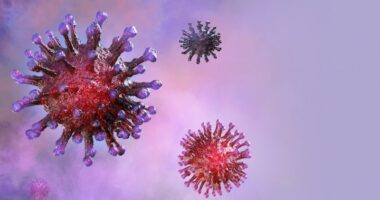Nifuroxazide Antibiotic Found to Stop, Reverse Induced PF in Mice

The approved antibiotic nifuroxazide halted the development, and reversed the signs, of induced pulmonary fibrosis (PF) in mice, a study showed.
These data support further research into the repurposing of nifuroxazide as a viable therapeutic option for people with PF, according to scientists.
The team noted that there were “still some shortcomings in the … administration and dosage of [nifuroxazide] that need to be improved,” but said “a more detailed understanding of [the use of this antibiotic] is worth investigating.”
The study, “Nifuroxazide ameliorates pulmonary fibrosis by blocking myofibroblast genesis: a drug repurposing study,” was published in the journal Respiratory Research.
PF is characterized by the abnormal activation and excessive growth of fibroblasts, the most common cell type in connective tissue, which produces the protein collagen and other molecules that lead to lung tissue scarring, or fibrosis.
Various inflammatory factors and multiple pathways have been linked to PF progression, including the proteins TGF-beta1 and Stat3, both of which play a role in the activation of fibroblasts. As a result, blocking pathways associated with these proteins may reduce fibroblast activation and lessen or reverse signs of fibrosis.
A time- and cost-saving approach to developing new medicines is to repurpose approved therapies that have effects against biological processes involved in non-indicated diseases.
Nifuroxazide is an approved oral medicine that blocks Stat3 and is used as an antibiotic to treat colitis, an inflammatory condition of the large intestine, and diarrhea. It also has shown efficacy against certain types of cancer, and reduced inflammatory responses and fibrosis in diabetic kidney tissue.
These findings prompted researchers at Sichuan University, in China, to investigate whether nifuroxazide might be an effective PF treatment, given the disease’s connection to Stat3.
Preliminary experiments confirmed that nifuroxazide targeted and firmly bound to the Stat3 protein in two different cell lines.
Researchers induced PF in mice by treating the animals with the chemical bleomycin. These mice were then administered two different doses (25 mg/kg or 50 mg/kg) of nifuroxazide by abdominal injection, given every day for 27 days.
After 28 days, severe PF was seen in untreated control mice. In contrast, mice treated with nifuroxazide showed a significant reduction in hydroxyproline, a major building block of collagen, and lower production of two proteins characteristic of fibrosis. Treatment also alleviated PF-induced structural damage and excess collagen production in isolated lung tissue.
Induced PF stimulated an immune response in the lungs, as measured by an increase in various immune cells that contribute to chronic inflammation and scar tissue formation. Nifuroxazide treatment normalized the number of these immune cells. At the same time, the therapy significantly lowered the production of various pro-inflammatory signaling molecules, including TGF-beta1, TNF-alpha, interleukin-6, and interleukin-4.
Treatment also blocked epithelial-to-mesenchymal transition (EMT) — a process in which cells that line the airways, known as epithelial cells, transform into another cell type, called mesenchymal cells. EMT occurs during wound healing and fibrosis.
Notably, induced fibrosis led to the abnormal activation of Stat3, which was decreased in response to nifuroxazide, “indicating that [the antibiotic] may inhibit pulmonary fibrosis by blocking abnormal Stat3 activation,” the researchers wrote.
Next, the team delayed treatment to 14 days after PF induction to evaluate the impact of nifuroxazide on established disease. This scenario showed that nifuroxazide prolonged survival, reduced hydroxyproline and fibrosis markers, and lowered the levels of pro-inflammatory factors. Importantly, treatment reversed induced lung inflammation, collagen production, and fibrosis.
“These results suggest that [nifuroxazide] promotes fibrosis resolution even when treatment is delayed,” the scientists wrote.
Lastly, cell-based experiments conducted to support these findings showed that nifuroxazide — in a dose-dependent manner — prevented the activation of fibroblasts and blocked the excess growth of activated fibroblasts isolated from rats with induced PF. EMT also was suppressed by nifuroxazide.
“Overall, in this study, we demonstrated that [nifuroxazide] ameliorates and reverses pulmonary fibrosis,” the authors wrote, noting that further research is needed into the mechanisms underlying its effects.
“These results support [nifuroxazide] as a viable therapeutic option for IPF treatment,” they concluded.









